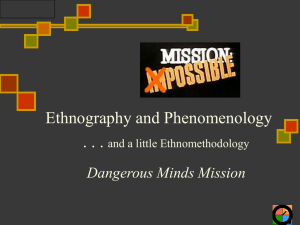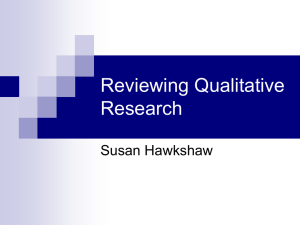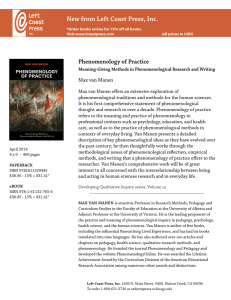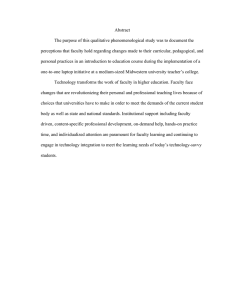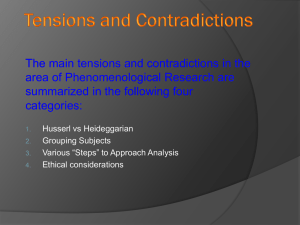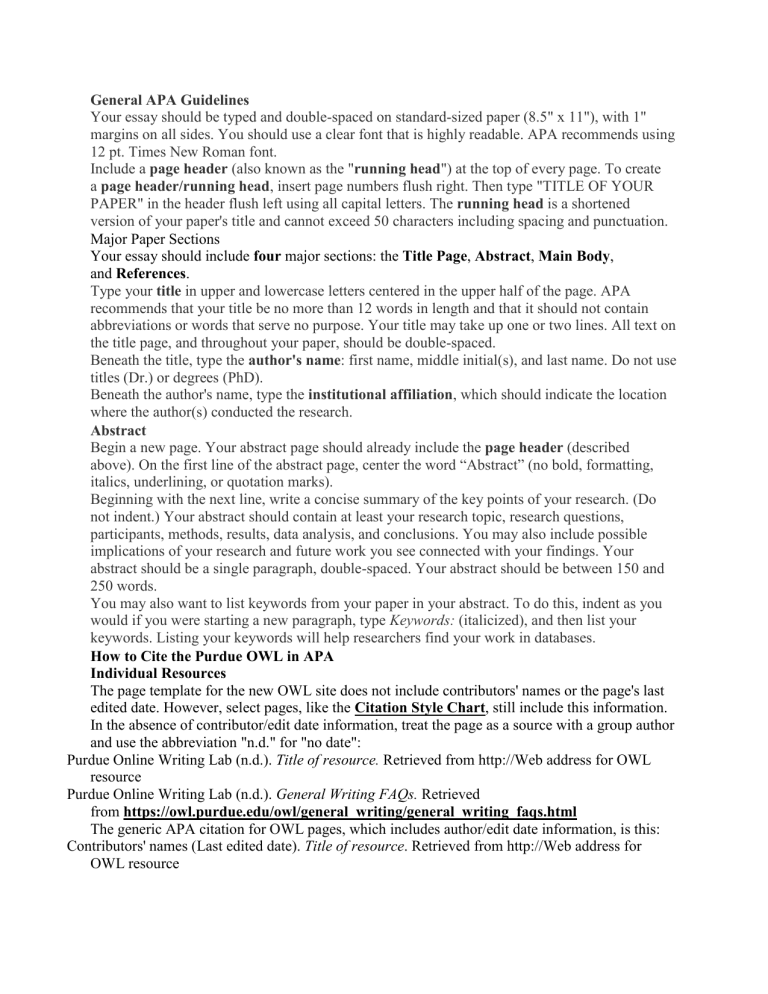
General APA Guidelines
Your essay should be typed and double-spaced on standard-sized paper (8.5" x 11"), with 1" margins on all sides. You should use a clear font that is highly readable. APA recommends using
12 pt. Times New Roman font.
Include a page header (also known as the " running head ") at the top of every page. To create a page header/running head , insert page numbers flush right. Then type "TITLE OF YOUR
PAPER" in the header flush left using all capital letters. The running head is a shortened version of your paper's title and cannot exceed 50 characters including spacing and punctuation.
Major Paper Sections
Your essay should include four major sections: the Title Page , Abstract , Main Body , and References .
Type your title in upper and lowercase letters centered in the upper half of the page. APA recommends that your title be no more than 12 words in length and that it should not contain abbreviations or words that serve no purpose. Your title may take up one or two lines. All text on the title page, and throughout your paper, should be double-spaced.
Beneath the title, type the author's name : first name, middle initial(s), and last name. Do not use titles (Dr.) or degrees (PhD).
Beneath the author's name, type the institutional affiliation , which should indicate the location where the author(s) conducted the research.
Abstract
Begin a new page. Your abstract page should already include the page header (described above). On the first line of the abstract page, center the word “Abstract” (no bold, formatting, italics, underlining, or quotation marks).
Beginning with the next line, write a concise summary of the key points of your research. (Do not indent.) Your abstract should contain at least your research topic, research questions, participants, methods, results, data analysis, and conclusions. You may also include possible implications of your research and future work you see connected with your findings. Your abstract should be a single paragraph, double-spaced. Your abstract should be between 150 and
250 words.
You may also want to list keywords from your paper in your abstract. To do this, indent as you would if you were starting a new paragraph, type Keywords: (italicized), and then list your keywords. Listing your keywords will help researchers find your work in databases.
How to Cite the Purdue OWL in APA
Individual Resources
The page template for the new OWL site does not include contributors' names or the page's last edited date. However, select pages, like the Citation Style Chart , still include this information.
In the absence of contributor/edit date information, treat the page as a source with a group author and use the abbreviation "n.d." for "no date":
Purdue Online Writing Lab (n.d.). Title of resource. Retrieved from http://Web address for OWL resource
Purdue Online Writing Lab (n.d.). General Writing FAQs.
Retrieved from https://owl.purdue.edu/owl/general_writing/general_writing_faqs.html
The generic APA citation for OWL pages, which includes author/edit date information, is this:
Contributors' names (Last edited date). Title of resource . Retrieved from http://Web address for
OWL resource
Paiz, J., Angeli, E., Wagner, J., Lawrick, E., Moore, K., Anderson, M.,…Keck, R. (2010, May
5). General format . Retrieved from http://owl.english.purdue.edu/owl/resource/560/01/
Introduction
The Purpose of the Study
Significance of the Study (or Rationale1)
Nature and limitations of the Study (optional}
Literature Review (optional)
Methodology
Target Population
Research design and Procedures
Miscellaneous Materials
Phenomenology has its roots in a 20 th century philosophical movement based on the work of the philosopher Edmund Husserl. As research tool, phenomenology is based on the academic disciplines of philosophy and psychology and has become a widely accepted method for describing human experiences. Phenomenology is a qualitative research method that is used to describe how human beings experience a certain phenomenon. A phenomenological study attempts to set aside biases and preconceived assumptions about human experiences, feelings, and responses to a particular situation. It allows the researcher to delve into the perceptions, perspectives, understandings, and feelings of those people who have actually experienced or lived the phenomenon or situation of interest. Therefore, phenomenology can be defined as the direct investigation and description of phenomena as consciously experienced by people living those experiences. Phenomenological research is typically conducted through the use of in-depth interviews of small samples of participants. By studying the perspectives of multiple participants, a researcher can begin to make generalizations regarding what it is like to experience a certain phenomenon from the perspective of those that have lived the experience.
Following is a list of the main characteristics of phenomenology research:
It seeks to understand how people experience a particular situation or phenomenon.
It is conducted primarily through in-depth conversations and interviews; however, some studies may collect data from diaries, drawings, or observation.
Small samples sizes, often 10 or less participants, are common in phenomenological
studies.
Interview questions are open-ended to allow the participants to fully describe the
experience from their own view point.
Phenomenology is centered on the participants’ experiences with no regard to social or cultural norms, traditions, or preconceived ideas about the experience.
It focuses on these four aspects of a lived experience: lived spaced, lived body, lived time, and lived human relations.
Data collected is qualitative and analysis includes an attempt to identify themes or make generalizations regarding how a particular phenomenon is actually perceived or experienced.
Researchers conducting phenomenological studies are interested in the life experiences of humans. This type of research can be applied to wide variety of situations and phenomena. Below are just a few examples of topics that would lend themselves to phenomenological study:
How do parents of an autistic child cope with the news that their child has autism?
What is it like to experience being trapped in a natural disaster, such as a flood or hurricane?
How does it feel to live with a life-threatening aneurism?
What is it like to be a minority in a predominantly white community?
What is like to survive an airplane crash?
How do cancer patients cope with a terminal diagnosis?
What is it like to be a victim of sexual assault?
The next modules in this series will explore phenomenology research methods, data analysis and the strengths and limitations of this type of research.
Suggested Readings:
Giorgi, A. (2012). The descriptive phenomenological psychological method. Journal of
Phenomenological psychology , 43 (1), 3-12.
Giorgi, A. (1997). The theory, practice, and evaluation of the phenomenological method as a qualitative research procedure. Journal of phenomenological psychology , 28 (2), 235-
260.
Hycner, R. H. (1985). Some guidelines for the phenomenological analysis of interview data. Human studies , 8 (3), 279-303.
Measor, L. (1985). "Interviewing: a Strategy in Qualitative Research" in R Burgess (ed)
Strategies of Educational Research: Qualitative Methods. Lewes, Falmer Press.
Moustakas, C. (1994). Phenomenological research methods. London, Sage.
Polkinghorne, D. E. (1989). Phenomenological research methods. Existentialphenomenological perspectives in psychology: Exploring the breadth of human experience , 41-60.
Starks, H., & Brown Trinidad, S. (2007). Choose your method: A comparison of phenomenology, discourse analysis, and grounded theory. Qualitative health research ,
17 (10), 1372-1380.
https://cirt.gcu.edu/research/developmentresources
The methodology used in phenomenology differs than most other research methodology because the goal is to describe a lived experience, rather than to explain or quantify it in any way. Phenomenology is solely concerned with the study of the experience from the perspective of the participants, therefore, the methodology does not include a hypothesis or any preconceived ideas about the data collected.
Phenomenology makes use of a variety of methods including interviews, conversations, participant observation, action research, focus meetings, analysis of diaries and other personal texts. In general, the methodology is designed to be less structured and more open-ended to encourage the participant to share details regarding their experience. Surveys and questionnaires that are commonly used in other research methods to gather information from participants would be too structured and would not allow the participant to freely share. In other words, phenomenology emphasizes subjectivity. The goal of phenomenological research methods is to maximize the depth of the information collected and therefore, less structured interviews are most effective.
Following is a list of principles and qualities applied to phenomenological methodology and data collection:
Phenomenology searches for the meaning or essence of an experience rather than measurements or explanations.
Researcher should begin with the practice of Epoche. He or she will describe their own experiences or ideas related to phenomenon to increase their own awareness of their underlying feelings.
Phenomenology is different in that the researcher is often participatory and the other participants are co-researchers in many cases.
This type of research focuses on the wholeness of the experience, rather than its
individual parts.
Phenomenology differs from other research in that it does not test a hypothesis, nor is there an expectation that the results predictive or reproducible. Additional studies into the same phenomenon often reveal new and additional meanings.
The study can be applied to a single case or deliberately selected samples.
A phenomenological research study typically follows the four steps listed below:
Bracketing – The process of identifying, and keeping in check, any preconceived beliefs, opinions or notions about the phenomenon being researched. In this process, the researcher “brackets out” any presuppositions in an effect to approach the study of the phenomenon from an unbiased perspective. Bracketing is important to phenomenological reduction, which is the process of isolating the phenomenon and separating it from what is already known about it.
Intuition – This requires that the researcher become totally immersed in the study and the phenomenon and that the researcher remains open to the meaning of the phenomenon as described by those that experienced it. The process of intuition results in an understanding of the phenomenon and may require the researcher to vary the data collection methods or questions until that level of understanding emerges.
Analysis – The process of analyzing data involves the researcher becoming full immersed into the rich, descriptive data and using processes such as coding and categorizing to organize the data. The goal is to develop themes that can be used to describe the experience from the perspective of those that lived it.
Description – This is the last phase of the process. The researcher will use his or her understanding of the data to describe and define the phenomenon and communicate it to others.
Suggested Readings:
Giorgi, A. (2012). The descriptive phenomenological psychological method. Journal of
Phenomenological psychology , 43 (1), 3-12.
Giorgi, A. (1997). The theory, practice, and evaluation of the phenomenological method as a qualitative research procedure. Journal of phenomenological psychology , 28 (2), 235-
260.
Hycner, R. H. (1985). Some guidelines for the phenomenological analysis of interview data. Human studies , 8 (3), 279-303.
Measor, L. (1985). "Interviewing: a Strategy in Qualitative Research" in R Burgess (ed)
Strategies of Educational Research: Qualitative Methods. Lewes, Falmer Press.
Moustakas, C. (1994). Phenomenological research methods. London, Sage.
Polkinghorne, D. E. (1989). Phenomenological research methods. Existentialphenomenological perspectives in psychology: Exploring the breadth of human experience , 41-60.
Starks, H., & Brown Trinidad, S. (2007). Choose your method: A comparison of phenomenology, discourse analysis, and grounded theory. Qualitative health research ,
17 (10), 1372-1380.
